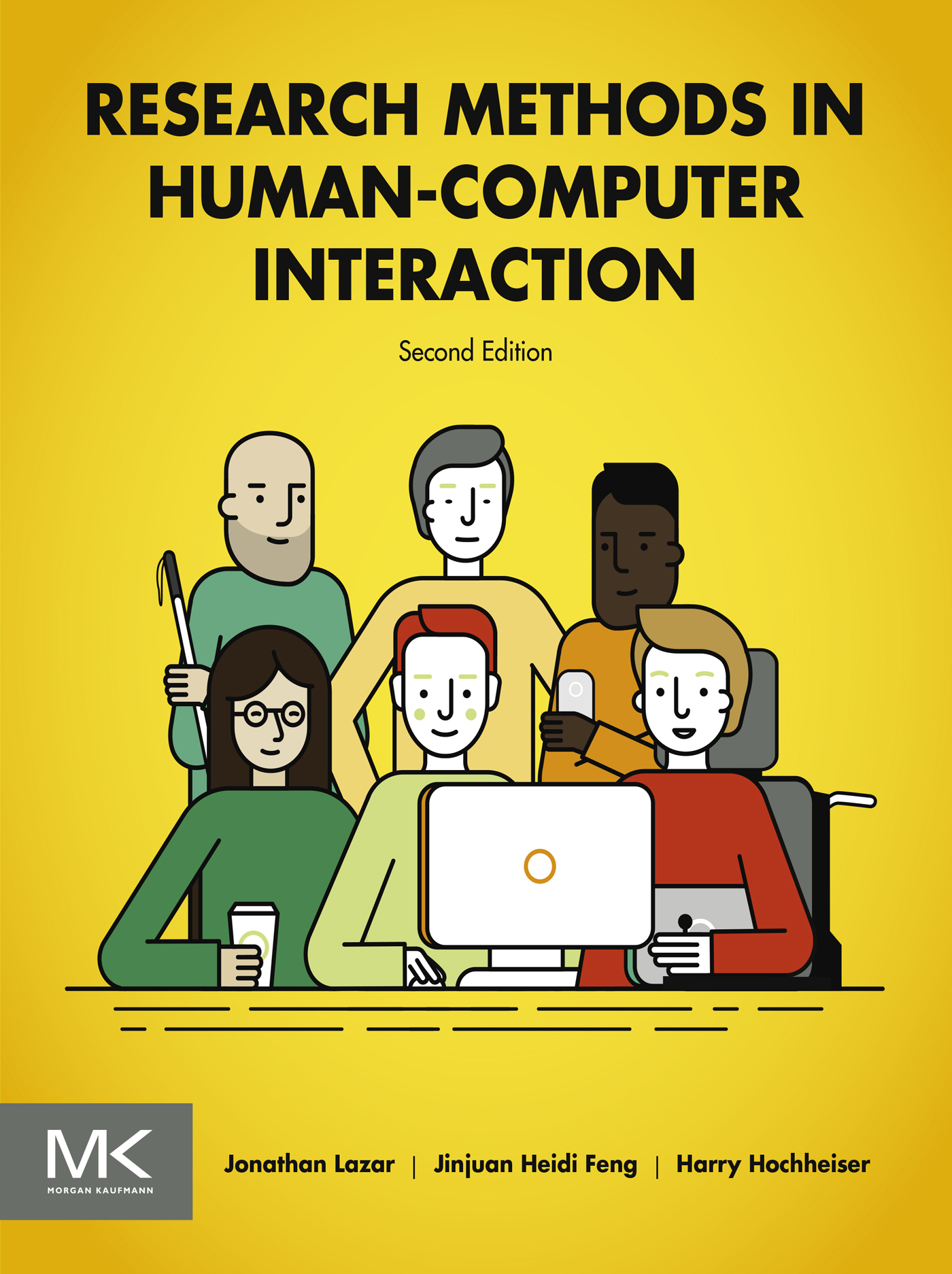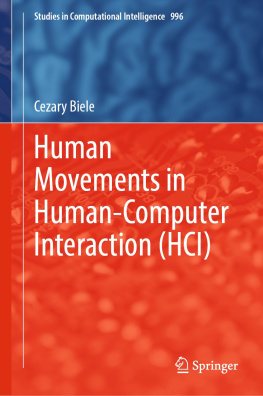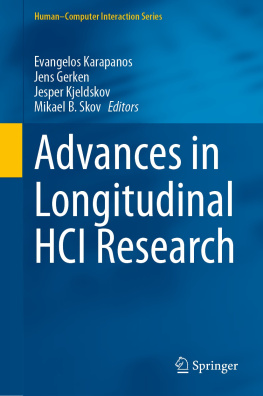Feng Jinjuan Heidi - Research Methods in Human-Computer Interaction
Here you can read online Feng Jinjuan Heidi - Research Methods in Human-Computer Interaction full text of the book (entire story) in english for free. Download pdf and epub, get meaning, cover and reviews about this ebook. City: Cambridge;Mass, year: 2017, publisher: Elsevier Science & Technology, genre: Politics. Description of the work, (preface) as well as reviews are available. Best literature library LitArk.com created for fans of good reading and offers a wide selection of genres:
Romance novel
Science fiction
Adventure
Detective
Science
History
Home and family
Prose
Art
Politics
Computer
Non-fiction
Religion
Business
Children
Humor
Choose a favorite category and find really read worthwhile books. Enjoy immersion in the world of imagination, feel the emotions of the characters or learn something new for yourself, make an fascinating discovery.

- Book:Research Methods in Human-Computer Interaction
- Author:
- Publisher:Elsevier Science & Technology
- Genre:
- Year:2017
- City:Cambridge;Mass
- Rating:5 / 5
- Favourites:Add to favourites
- Your mark:
- 100
- 1
- 2
- 3
- 4
- 5
Research Methods in Human-Computer Interaction: summary, description and annotation
We offer to read an annotation, description, summary or preface (depends on what the author of the book "Research Methods in Human-Computer Interaction" wrote himself). If you haven't found the necessary information about the book — write in the comments, we will try to find it.
Research Methods in Human-Computer Interaction — read online for free the complete book (whole text) full work
Below is the text of the book, divided by pages. System saving the place of the last page read, allows you to conveniently read the book "Research Methods in Human-Computer Interaction" online for free, without having to search again every time where you left off. Put a bookmark, and you can go to the page where you finished reading at any time.
Font size:
Interval:
Bookmark:

- Tables in Chapter 2
- Tables in Chapter 3
- Tables in Chapter 4
- Tables in Chapter 5
- Tables in Chapter 6
- Tables in Chapter 7
- Tables in Chapter 10
- Tables in Chapter 11
- Tables in Chapter 13
- Tables in Chapter 14
- Tables in Chapter 16
- Figures in Chapter 1
- Figures in Chapter 2
- Figures in Chapter 3
- Figures in Chapter 4
- Figures in Chapter 5
- Figures in Chapter 7
- Figures in Chapter 8
- Figures in Chapter 9
- Figures in Chapter 10
- Figures in Chapter 11
- Figures in Chapter 12
- Figures in Chapter 13
- Figures in Chapter 14
- Figures in Chapter 15
- Figures in Chapter 16
Second Edition
Jonathan Lazar
Jinjuan Heidi Feng
Harry Hochheiser

Morgan Kaufmann is an imprint of Elsevier
50 Hampshire Street, 5th Floor, Cambridge, MA 02139, United States
2017 Elsevier Inc. All rights reserved.
No part of this publication may be reproduced or transmitted in any form or by any means, electronic or mechanical, including photocopying, recording, or any information storage and retrieval system, without permission in writing from the publisher. Details on how to seek permission, further information about the Publishers permissions policies and our arrangements with organizations such as the Copyright Clearance Center and the Copyright Licensing Agency, can be found at our website: www.elsevier.com/permissions.
This book and the individual contributions contained in it are protected under copyright by the Publisher (other than as may be noted herein).
Notices
Knowledge and best practice in this field are constantly changing. As new research and experience broaden our understanding, changes in research methods, professional practices, or medical treatment may become necessary.
Practitioners and researchers must always rely on their own experience and knowledge in evaluating and using any information, methods, compounds, or experiments described herein. In using such information or methods they should be mindful of their own safety and the safety of others, including parties for whom they have a professional responsibility.
To the fullest extent of the law, neither the Publisher nor the authors, contributors, or editors, assume any liability for any injury and/or damage to persons or property as a matter of products liability, negligence or otherwise, or from any use or operation of any methods, products, instructions, or ideas contained in the material herein.
Library of Congress Cataloging-in-Publication Data
A catalog record for this book is available from the Library of Congress
British Library Cataloguing-in-Publication Data
A catalogue record for this book is available from the British Library
ISBN: 978-0-12-805390-4
For information on all Morgan Kaufmann publications visit our website at https://www.elsevier.com/books-and-journals

Publisher: Todd Green
Acquisition Editor: Todd Green
Editorial Project Manager: Lindsay Lawrence
Production Project Manager: Punithavathy Govindaradjane
Cover Designer: Matthew Limbert
Typeset by SPi Global, India
This book is an outstanding contribution to HCIs pedagogical and reference literature, reviewing and explaining the numerous research methods in common use. It motivates with numerous examples the methods in terms of posing questions and designing research to answer those questions. It covers well both quantitative and qualitative methods. The treatment is accessible and lively. The book should be considered for adoption by all HCI instructors.
Ron Baecker, Member of the CHI Academy, Founder and Co-Director, Technologies for Aging Gracefully lab (TAGlab), and Professor Emeritus of Computer Science, University of Toronto
This is the research methods book I recommend to my students and colleagues. And it's a time-saver: my students make fewer methodological mistakes and we can now engage in deeper and more insightful discussions about specific challenges of their research work. With this improved and updated edition, the bar is even higher! With increasing traces of our lives online and availability of Big Data in many research projects, the new chapter on online and ubiquitous HCI research was a welcome addition to the already comprehensive, multi-method research book. Every HCI student, researcher, and practitioner must read it!
Simone Barbosa, Professor, PUC-Rio, Brazil, and co-Editor-in-Chief of ACM Interactions
Research Methods in HCI is an excellent resource for newcomers and seasoned HCI professionals alike. Covering all the basic methods for conducting research in HCI, concepts are explained clearly and brought alive through case studies and examples. In addition to offering how-to details, the text offers detailed rationale for why and when to use different methods. Some historical context and controversial viewpoints are also offered. Clear discussions around how to select participants and work with different populations are offered, as are ethical issues in conducting research. The attention to these kinds of details makes this a truly engaging, readable text. The extensive list of references offers plenty of scope for follow-up for those wishing to deepen their knowledge even further. The 2nd edition offers new and refreshed content, updated examples and case studies, and new references and resources.
Elizabeth Churchill, Member of the CHI Academy, Secretary/Treasurer of ACM, currently Director of User Experience at Google, formerly Director of Human Computer Interaction at eBay
This book by Lazar, Feng, and Hochheiser is a must read for anyone in the field of Human-Computer Interaction. Their multi-discipline approach, housed in the reality of the technological world today, makes for a practical and informative guide for user interface designers, software and hardware engineers and anyone doing user research.
Mary Czerwinski, Principal Research Manager, Microsoft Research, Recipient of the ACM SIGCHI Lifetime Service Award, Member of the CHI Academy, and ACM Fellow
This is a superb book for all researchers, practitioners, and students interested in the investigation of anything related to HCI. This new edition has much needed information on research methods in HCI that have become prevalent, including crowdsourcing as well as new creative ways to collect and analyze qualitative data, two examples of essential skills for today's HCI students! Highly recommended!
Vanessa Evers, Full Professor and Chair of Human Media Interaction, Scientific Director of the DesignLab, University of Twente, the Netherlands
I recommend this book to all my PhD students. It provides excellent coverage of a range of HCI research methods, and importantly, the context for researchers to know how the methods relate to each other and how to choose a method that is appropriate for their own research question. The book is a very nice read. It is an excellent reference for HCI researchers, not only for those just starting out, but also for experienced researchers who would like to firm up their knowledge of HCI methods.
Font size:
Interval:
Bookmark:
Similar books «Research Methods in Human-Computer Interaction»
Look at similar books to Research Methods in Human-Computer Interaction. We have selected literature similar in name and meaning in the hope of providing readers with more options to find new, interesting, not yet read works.
Discussion, reviews of the book Research Methods in Human-Computer Interaction and just readers' own opinions. Leave your comments, write what you think about the work, its meaning or the main characters. Specify what exactly you liked and what you didn't like, and why you think so.






